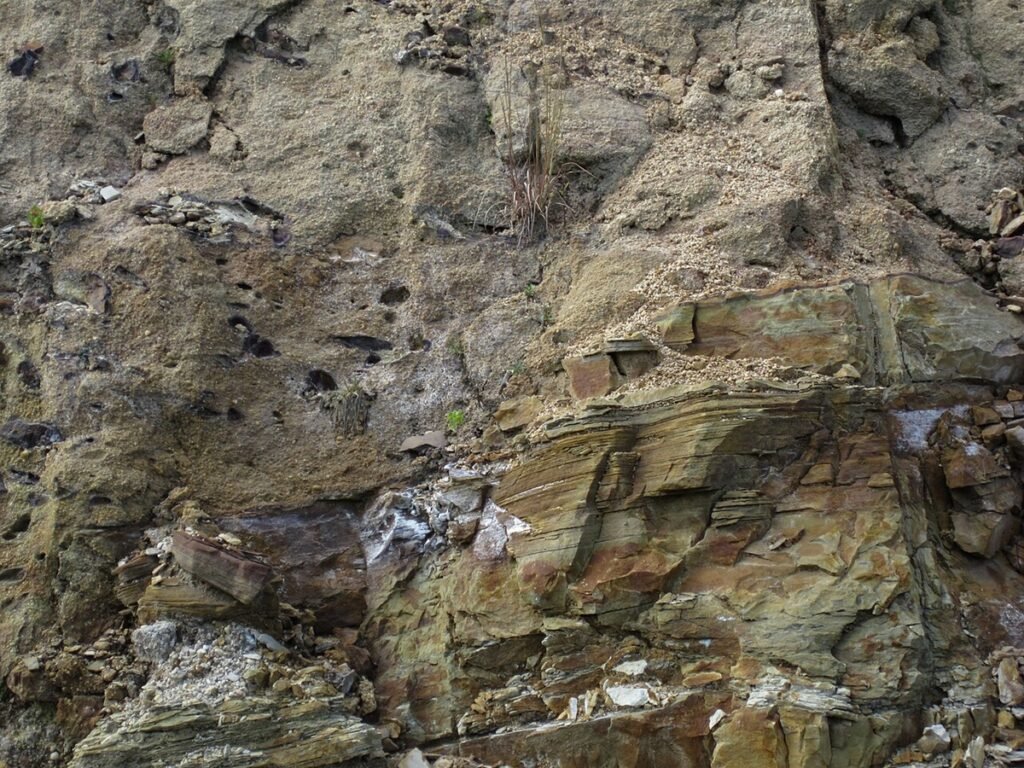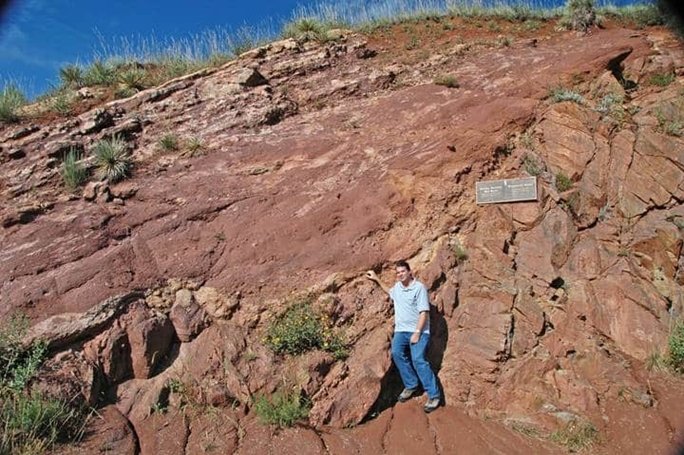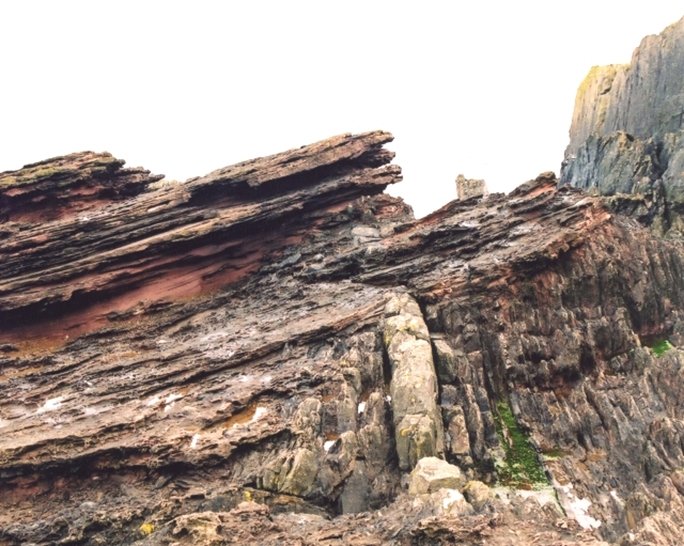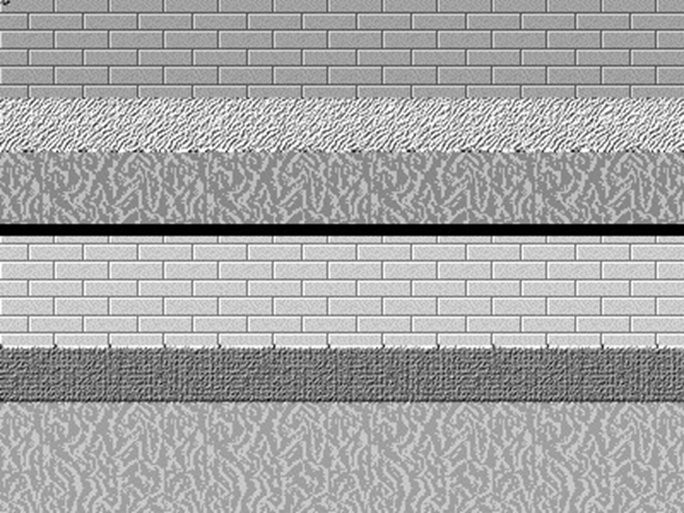Unconformity in geosciences, earth sciences, or geology refers to a buried surface of no deposition, erosion, or both, separating rock strata or masses of different ages with significant geologic record gaps.
Unconformities are, therefore, burial surfaces separating the upper younger rock strata or mass from the lower older ones.
These buried surfaces, i.e., non-depositional, erosional, or both, represent a discontinuity, disruption, or hiatus. A hiatus is a significant gap in the geologic record. It can be local or regional and can last for thousands to billions of years.
Unconformities usually represent a significant or measurable geological record gap. A short-lived disruption of deposition or a little erosion will form a diastema, while continuous deposition forms a comfortable contact. Diastemas are not unconformity-bounded rock unit.
Unconformity-bounded units refer to rock bodies above and below unconformities. These rock units above and below can be of the same rock type or different types.
To visualize what unconformity is, think of a surface on which significant erosion can remove deposited rocks, erasing the geological record. Deposition may alternatively cease for a significant amount of time, a period during which no geologic record is preserved. Sometimes, both erosion and non-deposition happen.
Later, new rocks form on top of the eroded or non-depositional surface, forming what we are calling an unconformity.
To denote unconformities on geologic maps, we use contact lines that differ from other contact lines used in these maps. For angular ones, the contact lines will have strikes and dips.

Conceptualization
James Hutton (1726–1797), a Scottish naturalist, farmer, and geologist, conceptualized the idea of unconformity. He specifically talked about angular unconformity but didn’t use the term unconformity.
From his observation of sedimentary features like ripple marks on tilted rock strata at Isle of Arran, Jedburgh, and Siccar Point, Hutton concluded that rocks were originally horizontal. These rocks probably tilted later and were eroded before submerging.
After submerging, younger rock strata were later deposited on top of the submerged rocks.
Before Hutton’s conceptualization, Nicholas Steno (1638-1686), John Strachey (1671-1743), and Jean Ettiene Guettard (1715-1786) made sketches showing angular unconformities. However, these three gentlemen didn’t explain their sketches.
Robert Jameson first used the term unconformity to describe Hutton’s idea before Henry De la Beche and Charles Lyell made it popular. It initially only referred to angular unconformity.
In the early 20th century, Eliot Blackwelde, Amadeus William Grabau, and Bailey Willis expanded this ideal to include the other types of unconformities, not just angular.
What causes unconformities?
The main cause of unconformity is erosion of exposed rocks followed by deposition of younger rock masses or layers. The other cause is deposition cessation, or both erosion and deposition cessation, followed by the formation of younger rocks.
Events like land uplift, folding, tilting, faults due to earth movements, or falls in sea level (regression) will expose rocks causing erosion.
Subsidence due to rising sea levels or transgression will, on the other hand, cause deposition of sediments. Sometimes subsidence can, however, cause erosion if water chemically dissolves some rocks.
Sequence stratigraphy studies reveal that the many transgressions and regressions of seas during the Paleozoic Era are behind the global unconformity-bound rock sequencies.
Lastly, deposition may cease if conditions don’t favor weathering or erosion to create sediments.
How does an unconformity surface form?
Unconformities may form when deposition ceases for a significant geologic time. Erosion can also remove rock layers representing significant geologic records, or both erosion and non-deposition periods can cause unconformities.
Later, volcanic activities or lithification of deposited sediments will form the upper, younger rock mass or strata.
This process forms a buried surface that represents a geologic record, a rock gap, or an unconformity.
Identifying unconformities
Unconformities can occur between sedimentary rocks or between sedimentary and igneous or metamorphic rocks. They can also happen between layered volcanic rocks like lava flows or pyroclastic rock deposits.
To identify unconformities, look at cliffs, rock outcrops, quarries, and riverbanks. You will see cannels, scour marks, paleosols (fossil soils), discordant dips, and missing or discordant fossils between unconforming strata.
Additionally, you can look for paleokarsts, basal conglomerate or clasts, continental deposits, and basal conglomerate to further help you identify unconformities.
In marine environments, mass movement deposits, glauconitic minerals, and manganese nodules will help identify where unconformities occur.
Finally, fossil records, lithology, and chronostratigraphic span should be significant enough to help in identifying unconformity-bound rock units.
Why are unconformities important?
Correctly identifying unconformities is important. They help in:
- Knowing more about the past, including events like folding, faulting, mountain building, metamorphism, igneous activities, changes in sea levels, or past climate and soils.
- Exploring oil, minerals like gold, aluminum, uranium, phosphates, or underground water because they mark zones of changes in porosity affect fluid migration. Some can create water aquifers and trap oil. For instance, the Carlin Unconformity has gold and silver.
- Knowing the relative ages of fossils and past events. Stratigraphers, geologists, and paleontologists can say if they happened before or after certain events or fossils.
- Identifying geologic hazards such as harmful minerals in the underground associated with a certain unconformity.
The 6 types of unconformities
Here are the six types:
1. Nonconformity
Nonconformity occurs where upper, younger sedimentary rocks lie above older volcanic or metamorphic rocks. This unconformity is easier to identify because it happens between different rock types, and dip and strike angles between the upper and lower rock units don’t matter.

1. Angular unconformities
Angular unconformities occur where younger and older strata are at different angles, meaning their dip, strike, or both differ. The upper strata or rock mass will lie flat above the lower, tilted, folded, or deformed older rocks.
Angular unconformities are easy to identify. They indicate tectonic activities like tilting, folding, or sometimes uplift happened first. Afterward, erosion planed the folds or tilted edges before the younger strata formed.

3. Disconformity
In disconformity, rock strata of different ages lie parallel to each other. Their plane of contact shows discernible irregular eroded surfaces, sedimentary, and other erosional features.
Some of the erosional and sedimentary features to help identify disconformities include stream channels, reliefs, paleosols, old karts, solution features, or large missing rock strata.

4. Paraconformity, non-depositional or pseudo conformities
In paraconformities, the younger and older strata are parallel to each other. They lack visible erosional features, making it hard to identify them unless you use fossil records.
Their lack of erosional features suggests they likely form from a non-depositional episode.

5. On lap or buttress unconformity
The buttress or onlap unconformity forms where the younger strata or rock mass is cut off or truncated by the older one.
The orientation of the younger or older rock strata doesn’t, however, matter.
To visualize these unconformities, think of sediments that are deposited in a shallow sea. Each layer will truncate at the edge of the island, which has older strata.
6. Blended unconformity
Blended unconformity lacks a clear plane of contact between the rock units of different ages. Only pebble beds, soils, or paleosols may incorporate the younger layer and grade into the older one.
